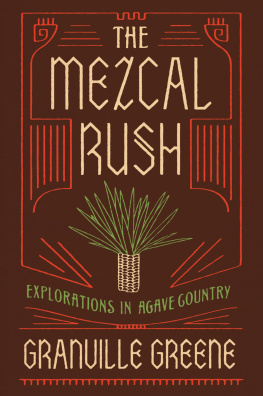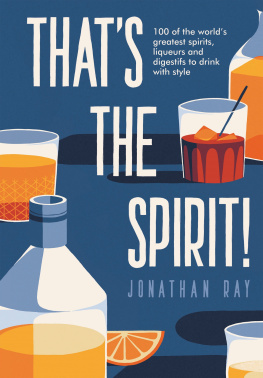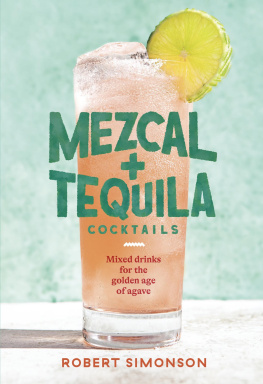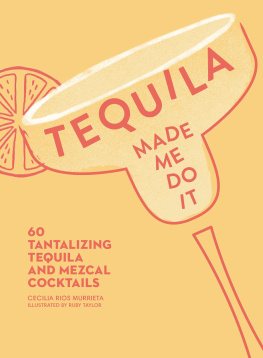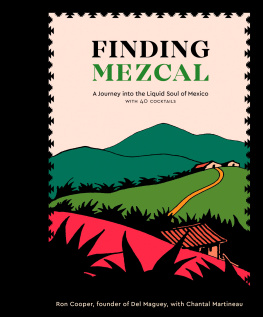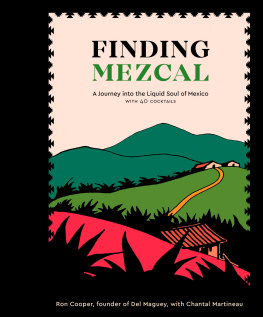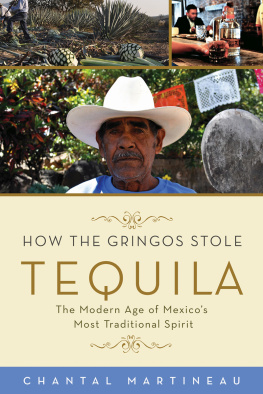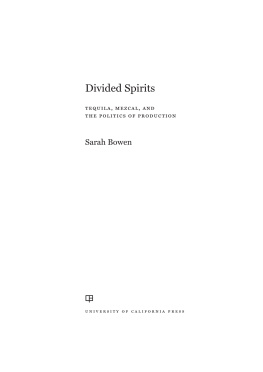
THE MEZCAL RUSH


Copyright 2017 by Granville Greene
All rights reserved under International and Pan-American Copyright Conventions. No part of this book may be used or reproduced in any manner whatsoever without written permission from the publisher, except in the case of brief quotations embodied in critical articles and reviews.
Library of Congress Cataloging-in-Publication Data is available
Cover design by Jennifer Heuer
Interior design by Megan Jones Design
eISBN 978-1-61902-895-1
COUNTERPOINT
2560 Ninth Street, Suite 318
Berkeley, CA 94710
www.counterpointpress.com
Printed in the United States of America
Distributed by Publishers Group West
10 9 8 7 6 5 4 3 2 1
for my parents and grandparents
Mescal, Yvonne said brightly.
The air was so full of electricity it trembled.
M ALCOLM L OWRY, U NDER THE V OLCANO
PROLOGUE
E ARLY ONE EVENING, Juan and Miguel, landscapers who work in my neighborhood in Santa Fe, stopped by in their pickup. They knew I was writing about the Mexican spirit mezcal , and they had a drink they wanted to share with me from their home in the state of Chihuahua. The clear liquid filled about a third of its hand-blown glass bottle, and the men watched me intently as I took a small sip. It was fiercely strong, yet rich with distinctive flavors that took me on several excursions at once. But mostly, it tasted alive.
What was it?
Its sotol from the mountains, Juan beamed.
During my visits to Mexico (which included spending nearly a year in the state of Oaxaca for this book), I had learned that sotol is a distillate of the Desert Spoon plant, Dasylirion wheeleri . With its slender, pointed spines, the succulent is sometimes mistaken for the agave plants that are used as the materia prima for mezcal distillation. They are related, and like agave, Desert Spoon grows on both sides of the border and has been a valuable resource for indigenous peoples for thousands of years. The strong fibers from the leaves of both plants can be extracted to weave baskets and cord, and their fleshy cores can be baked for food or cooked, mashed, and fermented for distilling spirits. Desert Spoon is named after the base of its leaf, which can be used as a utensil.
Juan and Miguels sotol had been crafted in and for their community, from local plants, by artisanal methods passed down through generations. Along with traditionally distilled mezcal, bacanora , raicilla , and other Mexican spirits that use agave, sotol is a labor-intensive drink that historically has been made in small batches and reserved for important events in a village. But it has long found its way across the frontier, and versions have even been fabricated in the U.S. With occasional sips enjoyed along the journey, the mens unbranded bottle had been handed, amigo to compadre , all the way from the rugged slopes of Mexicos Sierra Madre Occidental, across the international boundary straddling the great Chihuahuan Desert, and up the interstate blacktop partly laid over the ancient Camino Real trade routeuntil the last swigs were given to me in the Sangre de Cristo foothills.
The guys wanted to hang on to their handsome vessel, so I transferred its contents to a jam jar and put it on a shelf loaded with dozens of other glass containers, every one filled with a handcrafted Mexican spirit that tells an individual story of people, plants, and place. For me, the carefully authored drinks in my small collection represent only a few great books from a vast library that I know I can never fully read, and are written in languages that Im ill equipped to understand. Im not a botanist, a booze pundit, an anthropologist, or any other type of expertIm just an amateur who wanted to learn more. But for Juan and Miguel, each time they sip their sotol it is as if they are swallowing a liquid version of home. The distillates unique essences reconnect them to the culture they remain spiritually a part of, yet have physically left behind. It doesnt matter if their local sotol tastes good or bad, or if anyone else likes it. The drink is a reflection of who they areand that is something to be proud of.
Moved by their generosity, I found myself wishing that their gesture had been my initiation into the fascinating world of Mexican spirits. But the reality was far less memorable. As with the vast majority of other U.S. consumers, my first experiences had been with industrially manufactured tequila and cheap commercially made mezcalthe type with a worm at the bottom of the bottle, the ten yards of barbed wire fence that the novelist Malcolm Lowry has his alcoholic consul hooked on in Under the Volcano .
I sampled such mass-produced agave products from the early 1980s, during my college years, until 1998, when I encountered a far more exceptional Mexican drink: a pricey bottle of Oaxacan mezcal that had been micro-distilled from Agave angustifolia , commonly known as espadn . It was handmade by a family in the remote Zapotec village of Santo Domingo Albarradas, but I found it repackaged in a gourmet food-and-wine store in Santa Fe. When I brought it home and tried it, the spirits delectable flavors seeped into my consciousness like an otherworldly piece of music. It tasted completely different from any mezcal I had tried before, and I became so taken by it that I wanted to learn more about what it was, who made it, and where it came from.
At the time, artisanally crafted mezcal was only just beginning to appear on the radar in the U.S., and there wasnt much information about it. I realized that the best way for me to learn about the spirit was to head to Mexico, where, according to new studies, it has been distilled for thousands of years. My instruction began in 2000, when a magazine sent me to Oaxaca, home to the widest variety of agaves and the mezcals that are made from them. There, I was awakened to the extraordinary diversity of family-produced Mexican spirits.
Manufacturers of tequila use only one type of plant, Agave tequilana , and because they generally steam its heart in industrial machines, their product has a somewhat neutral taste. But traditional mezcals celebrate the diverse characters of numerous agave species, which are roasted in underground wood-fired ovens that infuse the drinks with their distinctive smoky notes. The nuanced flavors reflect myriad variations in landscape, soil, microclimates, airborne yeasts, and distillation techniquesnot to mention the ingenuity of their makers. On that first visit to Oaxaca, and during my subsequent explorations for this book, I grew to respect the spirit as one of Mexicos most poetic creations. Each mezcal can be an eloquent expression of the alchemist crafting it, even functioning as an unspoken language among the members of a community.
These days, the drink is on the move, finding its way to hip bars from Rome to Tokyo. Mezcal has been adopted by the Slow Food and craft-spirits camps, and helps to quench a burgeoning thirst for authenticity that has taken hold of many consumers. Yet what is almost certainly the oldest distilled beverage of the Americas remains largely unknown in relation to its hugely popular cousin, tequila, which has skyrocketed in worldwide sales over the past few decades. English-language dictionaries still even spell mezcal in an archaic form: mescal. Its relative obscurity is due not only to the unsavory image its been saddled withthe drink with the wormbut also, in class- and race-conscious Mexico, to its historically having been identified with the countrys marginalized indigenous populations. The diverse peoples who traditionally make mezcal have long been excluded from defining the spirit for Mexican and international markets.
Next page
